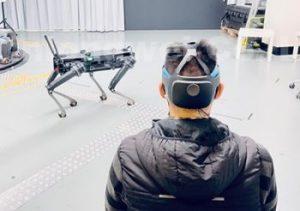
The self-imposed challenge was to be able to sense through hair – a far more challenging situation that sensing from bare skin.
Starting material for the electrodes is a silicon wafer topped with a thin silicon carbide surface.
Lithography and etching was used to pattern an array of hexagons and then etch these into short hexagonal silicon pillars ~100μm across and 10μm tall, still with a 500nm thick layer of SiC on top of each.
Using temporary nickel plating and thermal treatment, the top of the SiC was converted to polycrystalline graphene, with the nickel silicide waste removed chemically.
Eight of these electrodes, each ~1cm3 in area, where attached to a broad rubber strip and tied over the visual cortex at the back of a volunteer’s head – a part of the scalp both strongly curved and typically hairy – with 5mm stubble in this case.
According to the team, gathered from across the University of Technology Sydney, wet Ag-AgCl electrodes typically achieve 5-30kΩ (50Hz) contact resistance and 30±5dB signal-to-noise ratio, which is exactly what they achieved in the control part of this experiment. Conventional dry electrodes, they said, tend to score >200kΩ and 5±3dB even on bare skin.
The eight dry micromachined silicon-graphene electrodes scored variously, from 5±5dB to 25±5dB (averaging to ~15dB) over 5mm hair, and the researchers argue that shifting to a custom helmet from the ad hoc rubber strap could raise the average closer to the 25dB figure.
In a demonstration of the electrodes, a robot dog was controlled through the eight electrodes, with the volunteer looking at one of several white squares on a display depending on what the robot was required to do.
Each of the squares flashed differently, something that could be picked up from the visual cortex by the dry electrodes through the skull, scalp and hair.
“Though the new electrodes didn’t yet work quite as well as the wet sensors, the researchers say that this work represents a first step toward developing robust, easily implemented dry sensors to help expand the applications of brain-machine interfaces,” according to the University.
The work is covered in detail in ‘Noninvasive sensors for brain-machine interfaces based on micropatterned epitaxial graphene‘, published in ACS Applied Nano Materiels (whole paper can be read without payment).